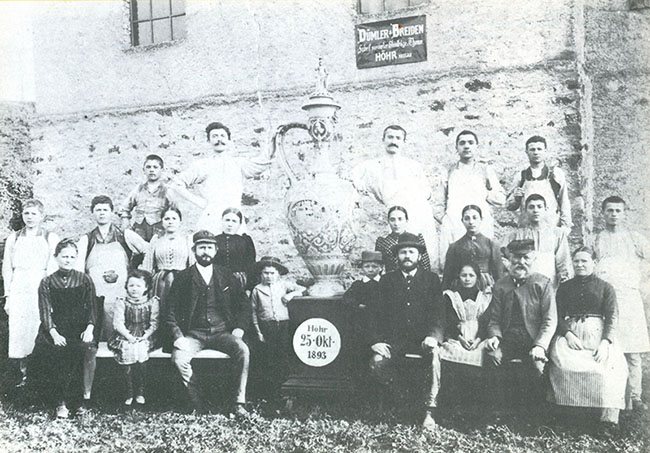
This article is intended as an adjunct to the on-line Dümler & Breiden Stein Catalog in the Beer Stein Library. Clicking on any of the various links provided herein will produce a separate window displaying the catalog listing associated with the item cited in the text.
—————————
When I first began researching the firm of Dümler & Breiden several years ago, I was surprised to discover that although the company ranked among the most important Westerwald manufacturers during the “Golden Age” of German beer steins in the late 19th and early 20th centuries, little had been written about D&B, especially in English. Moreover, what existed was typically laced with misinformation, particularly with respect to identifying and dating D&B steins. A slightly brighter picture exists when one turns to published German materials, but even there, with one or two notable exceptions the literature is largely limited to biographical material on Peter Dümler and Albert Breiden and sheds little light on some of the questions most important to collectors, i.e., What did they make? When did they make it? How does one identify it? and so on.
Of course, the stories of the people whose efforts created and sustained the company, as well as the events that both led to and shaped those efforts, can hardly be ignored. So we’ll start with a brief history of the company and it’s main players, after which the focus will turn more directly to the beer steins they produced, with an eye toward providing readers with the ability to identify and collect Dümler & Breiden steins with confidence.
Historical Backdrop
The Early Years
Peter Dümler was born in 1860, the first child of Westerwald potter Andreas Dümler and his wife Anna Maria. That same year saw the birth of Albert Breiden, seventh born child in the family of Jakob Breiden, a Grenzhausen mustard mill owner and his wife Mary Louise. For our purposes here, it’s important to note that Albert’s mother was also the sister of Simon Peter Gerz, a ceramics factory owner whose name is well known among beer stein collectors, so both boys were exposed at an early age to the industry that was to be their future.
In school the boys became fast friends and, as was the practice in those days, at age 14 they each began an apprenticeship that would provide the skills they would later need to make their way in the land of the Westerwald potters. Peter Dümler’s artistic talents had been recognized early on and he was apprenticed as an artist and modeler to Reinhold Hanke, another well known Westerwald factory owner. Reinhold Hanke is generally credited with being the first to apply 19th century Historismus (or Historicism) concepts to the German ceramics industry. It was here that Dümler gained his appreciation for Renaissance and Baroque pottery, as well as for German history in general, which as we will see shortly, is reflected in much of the work he’s remembered for today, including a wide range of pieces produced for Hanke in the late 1870s and early 1880s that make it clear how quickly his talent catapulted him into a role as one of Hanke’s leading designers.
As might have been expected, Albert Breiden was apprenticed to his uncle, S.P. Gerz, where he learned the technical side of the business, from clay procurement to glazing and firing, making him the perfect match for Dümler as a business partner. By the time their apprenticeships were completed, together they knew everything they needed to know to begin producing ceramics on their own. And so they did.
In 1883, the firm of Dümler and Breiden was born. Although the official German trade registry records the founding date of the company as July 1, 1884, the company itself publicly claimed 1883, no doubt reflecting a period during which start-up activities were undertaken prior to any formal legal filing. In fact, evidence exists making it clear that by 1884 production was well under way and the company’s first cataloged products were being offered for sale.
For the first several years money was scarce and the going difficult. Beyond the two principals, the company managed to employ only four additional workers, two turners and two apprentices, all of whom initially worked for shares in the business. Slowly but surely over its first decade the firm of Dümler & Breiden began to prosper, in large part due to the growing recognition of Peter Dümler’s artistic talents and his unique ability to produce contemporary designs reflecting Germany’s rich history and ceramics traditions. By 1893 the D&B workforce had expanded to forty-five employees, and planning was underway for an 1895 move to expanded facilities that were to include not only more room for production, but also a showroom and housing for the growing families of both company founders.
It was in 1893, with the company now firmly established on the Westerwald landscape, that the picture in Figure 1 was taken, depicting one of the highlights of the company’s year. First published in a 1983 brochure produced on the occasion of D&B’s 100th anniversary, it depicts Dümler, Breiden, members of their respective families and a handful of company employees showing off a huge 2.1-meter tall Schaukanne (exhibition jug) of the “old German type,” quite possibly the largest ceramic vessel that had been produced up to that time, and made for “one of the largest breweries in the world in the USA.” Peter Dümler sits in the front row on the left side of the photo with his wife Bertha standing behind him and his son Paul to his right (more about Bertha and Paul below). Similarly situated on the right side is Albert Breiden, along with his wife Bertha (née Dümler, Peter’s sister). The the name of the brewery that purchased this remarkable piece has been lost over time, but the Schaukanne itself surprisingly resurfaced in early 2020, sadly with extensive damage and, as this is written, is in the process of being restored.
 |
The remainder of the 19th century was a prosperous, if largely uneventful period for the firm of Dümler & Breiden, as well as for the Westerwald ceramics industry in general. The tastes of the buying public had begun to shift, moving away from the Historismus style and more toward depictions of contemporary Germans engaged in the common activities of everyday life, but with an artist like Peter Dümler at the helm, D&B was easily able to adapt to changing preferences. By the end of the 19th century the D&B product line was filled with ceramic interpretations of leading genre artists like Franz Defregger, not to mention similar original stylings, at least some of which can be directly attributed to Dümler himself (see, for instance No. 370). Comfortably positioned in the marketplace and with a steady flow of incoming orders, the company’s future seemed bright. With the demanding requirements of a start-up company for time and capital now in the past, Dümler had also gained the freedom to more fully indulge in his long-standing passion for Renaissance and Baroque pottery, ultimately amassing a world class collection that was proudly displayed in the company compound. Little did he realize at the time the important role his collection would play in the future of both the firm and his family.
Changing Times and New Directions
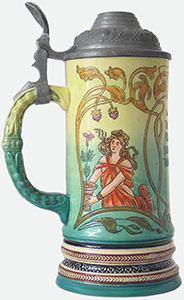 |
Figure 2. shows what was almost certainly a Dümler design (model No. 552), described in the company’s catalog as “female portraits and modern ornamentation.” As may be seen here, one of those females is depicted only barely clad in flowing ribbons, an image that would be considered avant-garde on a beer stein even by today’s standards, yet this stein was first produced circa 1899.1 Even the coloring was quite unusual for the time.
By 1902 “modern” designs were emerging from the D&B factory with some degree of regularity, putting the company in the vanguard of the Westerwald’s stylistic transition (see, for instance, Nos. 666 and 671).
However, it was Peter Dümler’s oldest son Paul whose designs were to become the company’s signature pieces in the Jugendstil era, and the first of those didn’t see the light of day until at least 1906. The earliest beer stein of Paul Dümmler’s to make it into the D&B catalog is believed to be model No. 787, a modern form displaying an equally modern interpretation of the classic “Lindenwirtin” scene.2
Paul Dümler had been born in 1887 and had received formal training at both the Royal Ceramic School in Höhr and later the Academy of Art in Munich. Sadly, but seemingly fortuitously, his coming of age as a ceramics artist and modeler coincided closely with the passing of his father, Peter Dümler, who died in 1907 at the age of only 47. Arguably the most important ceramics artist of his time, designer of not only beer steins and other mass produced items, but many one-of-a-kind masterpieces that can be seen today in museums throughout Europe, the death of Peter Dümler left a massive creative void in the company he left behind — a void that his son Paul would be quickly called upon to fill.
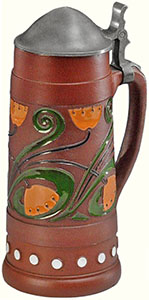 |
Of course, a glaze alone wasn’t enough to build the bridge to a new post-Peter Dümler era, but combined with the modern stylings of Paul Dümler, who was now providing the firm’s artistic leadership, Dümler & Breiden was able to produce a unique and popular product line that proved immune to imitation by its rivals. Paul Dümler’s simple but appealing enameled designs and the terra sigillata glaze seemed almost made for each other, proving so popular that beginning in 1910 and for at least a decade thereafter the vast majority of new products introduced by the company were Paul Dümler terra sigillata creations.3 The first beer stein to be listed in a D&B catalog as “terra sigillata” was produced as model No. 937. Shown in Figure 3, it’s a brightly painted, 1-liter piece entitled simply “Flowers.” Perhaps indicative of its popularity, that same design was also sold in ¾, ½, ¼, and ⅛-liter sizes as model numbers 938, 939, 940 and 941 respectively.
Over the next few years, the company continued to prosper, but in 1913 there was yet another change at the top. During that year Albert Breiden sold his stake in the firm to Peter Dümler’s widow Bertha for the sum of 50,000 Goldmarks (in today’s terms about $725,000), a purchase funded by the sale of the Dümler Renaissance and Baroque pottery collection mentioned earlier. Paul Dümler was promoted to the role of Geschäftsführer (Managing Director) and Breiden moved on, eventually taking over the management of S.P. Gerz, the firm once owned by his uncle where he had apprenticed as a boy. It is unclear whether this change was brought about by some sort of rift between Breiden and Bertha Dümler, who had earlier inherited her late husband’s share in the company, or was simply the result of a decision by Breiden to try something new, but for better or worse, on the eve of World War I Peter Dümler’s heirs were now in total control of the company.
At the time, the Dümler family could hardly have been unaware that war was likely and, in fact, there is evidence that they were making preparations for that eventuality well before the first shots were fired in the summer of 1914. By the time Paul Dümler left that year to join the army it would appear that he had managed to stockpile more than 300 product designs to be used in his absence, including a wide range of household items from ash trays to vases, not to mention a good number of beer steins. Tragically, he was never to return and those designs would become his legacy. Paul Dümler died on a battlefield in France shortly after the war began, at only 27 years of age.
To make matters worse, with the start of the war German exports had been dramatically curtailed, which for the firm of Dümler & Breiden meant an immediate drop in sales of about 80 percent. The steps the company had to take to deal with the economic reality of war can only be guessed at today, but it’s interesting to note that the rate of new product introduction appears to have held fairly steady during the war years and shortly thereafter, so that by the early 1920s Paul Dümler’s entire store of new designs had been pretty much used up. Surprisingly, by that time the company also seems to have recovered smartly from whatever pain it had suffered during the war. A filing in 1909, just five years before the war began, shows D&B employment at 50 workers. By 1920 that figure had soared to 70 (a 40% increase), this at a time when most Westerwald potteries were struggling to simply survive. Exceptional management must certainly have been a major factor in this success, but the advantage provided by possession of the secret to terra sigillata glazing cannot be underestimated.
Between the Wars and Beyond
In 1920, the listed owners of Dümler & Breiden were second son Sebald Dümler and his sister Antonia. Sebald had taken over the role of Managing Director following the departure of his brother Paul, while Antonia apparently had no active role in the company at all. Shortly thereafter she was to marry and leave the area completely.
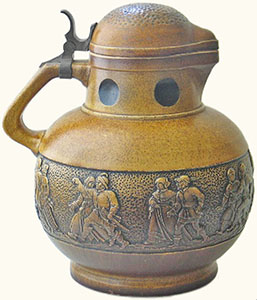 |
In the 1920s, Dümler & Breiden, like many Westerwald potteries, was struggling to find clear direction, a fact reflected in much of the output of the time. The Jugendstil period was drawing to a close and, for Dümler & Breiden, the difficulties this void created were compounded by the fact that interest in terra sigillata wares was also on the wane. A not at all atypical example of the kinds of pieces that emerged from D&B during the early to mid-1920s can be seen in model No. 1470 (Figure 4), a lidded serving vessel in a shape that clearly reflects the Jugendstil style, but with a central frieze that echoes the Historismus period, made up of images taken from a series of woodcuts by Renaissance engraver Hans Sebald Beham. While no documentation for this piece is currently known to exist, the timing of its release would lead one to believe that the design is the work of Ernst Dümler.
Throughout the 1920s and 1930s terra sigillata remained in use, but almost always as one of several available glaze options. Model No. 1633, probably introduced circa 1930 provides a good example. While the design and coloring on the terra sigillata version were very much in the Paul Dümler tradition, the same piece was also available in brown on black, a glaze option seen frequently on D&B products of the latter period.
By this point the Art Deco movement was in full swing, even in the Westerwald. Unfortunately, while the period produced more than its share of innovative ceramics, the beer steins of the 1930s, including those from Dümler & Breiden, were often either relatively low-grade imitations and reproductions of far more desirable steins from the “golden age,” or uninspired new designs that almost can’t help but leave collectors with an overall sense of sameness. This problem was compounded by the tin shortages in Germany at the time that often required the application of nearly formless nickel-plated pressed metal lids.
There were, of course, exceptions, and a small number of steins with considerable aesthetic appeal managed to emerge from D&B during that era. Take, for instance model No. 1727, decorated with drinking related animal symbolism in an Art Deco style. Even with plain white figures on a cobalt blue background (or perhaps because of it) the design is striking. For different reasons, No. 1753 and No. 2093, among others, should also have some appeal to serious collectors.
Unfortunately, by the time the last of those steins was being made in the late 1930s, Dümler & Breiden was in the final stages of exiting the beer stein business. At least a few D&B steins are known to exist from the early post-war period, but none that I can imagine ever becoming particularly desirable collectibles.
Although we’ve come to the conclusion of our brief look at the history of Dümler & Breiden from a stein collecting perspective, the life of the company was far from over. By the end of the 1950s, under the leadership of Peter Dümler’s third and youngest son Dietrich, D&B had redefined itself as an innovative producer of “Postwar Modern” pottery and was experiencing a period of revitalization and explosive growth that would take it well into the second half of the 20th century, but that’s another story.
At this point we’ll turn our attention more fully to the business of recognizing and collecting D&B beer steins.
The Art (and Politics) of Peter Dümler on Beer Steins
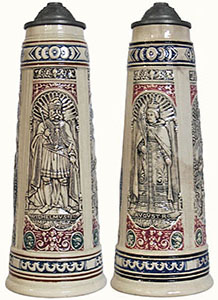 |
Dümler & Breiden’s very first cataloged beer stein (model No. 11), shown in Figure 5, was a ¼-liter “Pinte” entitled “Kaiser Wilhelm in Coronation Regalia.”4 The central image, taken from a design Dümler had created several years earlier for Reinhold Hanke5, depicts Wilhelm I dressed as a Roman Emperor, and exemplifies Dümler’s strong patriotic support for the newly unified empire that had emerged in the wake of Germany’s decisive victory in the Franco-Prussian War of 1870-71. The stein is dated 1884 and signed “PD” in the mold.
An interesting sidelight to this stein is the fact that an uncataloged mate exists (Figure 5, right), with the Empress Augusta (1811-1890) replacing Wilhelm I in the central image. I’m personally aware of only a single extant example of the Augusta version, also bearing the model No. 11, but both versions are pretty rare, so there’s really no telling at this point whether it was a mass-produced item or not.
It should be pointed out here that of all the cataloged D&B steins that appeared during Dümler’s lifetime, literally none bore any identifying base markings other than a model number, so the appearance of Dümler’s signature has been one of the few certain methods available for assuring that he was directly responsible for a particular design. Some variations of the “PD” signature (usually, but not always, a P within a D) are shown in Figure 6.
Unfortunately, only a small percentage of Dümler’s output bears a “PD” signature, with the last currently confirmed example appearing on model No. 391 (circa 1894). That being the case, somewhat less reliable stylistic cues are all that’s typically available for attribution purposes from that point on. There is, however, some good news with respect to earlier items. From 1884 through at least 1889 (around model No. 200) the staffing situation at Dümler & Breiden was such that there were simply no other horses in the stable, so all steins within that model number range can be reasonably attributed to Dümler himself.
 |
A second typically Dümler-like presentation of a contemporary political theme can be seen in stein No. 79, 4.5-liter piece called “The Watch on the Rhine,” the name having been taken from a 19th century political anthem calling for vigilance against possible incursions by France across the Rhine River into Germany. The centrally depicted Germania, ancient personification of German strength, unity and liberty, is flanked on both sides by depictions of early German warriors, a clear reference to the struggle between ancient Rome and Germanic tribal groups for control of the territory east of the Rhine, in which the Germans ultimately prevailed at the battle of Teutoburg Forest in 9 A.D. As in the previous example, the use in this design of references to ancient history as a device for expressing contemporary political views can be found throughout Dümler’s work, a trait rarely seen elsewhere.
Early Germans
Dümler appears to have been infatuated by his ancient forebears, who are regularly depicted, typically engaging in one of three principal activities, i.e., fighting with Romans, hunting or drinking. Examples created throughout his lifetime exist in multiple formats, including low relief, high relief and “etched,” but all rendered in styles that are generally not at all difficult to distinguish from the work of others.
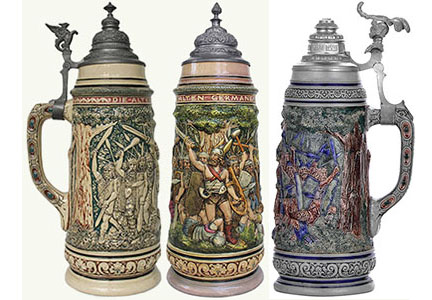 |
At this point in our discussion, it’s useful to note that early Dümler & Breiden steins were generally available with any of three different coloring and body type options, including “einfach bemalt” (1, 2 or 3-color) and “ganz bemalt” (full-color) pottery (i.e., ivory or cream stoneware), as well as salt-glazed blue-gray stoneware. Most, if not all, steins produced until circa 1895, the year of the move to expanded facilities, could be purchased with any of the three finishes, after which salt-glazing appears to have been largely discontinued. Only very rarely is a D&B stein found in a salt-glazed version known to have been produced following 1895 (i.e., with model numbers around 400 and above). What that implies, of course, is that nearly every example of a salt-glazed blue-gray stoneware D&B stein will have had an actual production date prior to 1895, while the production of its pottery counterparts may have occurred over a far greater time span. From another perspective, although versions of model No. 58 can be found with each of the three finishes, 1-liter and 2-liter steins with the same image (Nos. 555 and 559 respectively), are known to exist only as Elfenbeinsteinzeug (ivory stoneware).
A perfect companion to the stein shown in Figure 7 is the 4-liter D&B No. 117. Designed (and signed) by Dümler just a couple of years later, it contains three scenes depicting events occurring immediately after the Battle of Teutoburg Forest. The front scene, entitled “German Singer” in the mold, presumably shows the glorification of Arminius (Hermann) and his fellow warriors in song, the principal means by which such tales were transmitted in a culture that would not achieve literacy for another several hundred years. The scene on the right side, entitled “Hermann abducts Thusnelda,” actually depicts what in those days was a fairly common form of elopement, in this case resulting in an exchange of marriage vows shortly thereafter, despite the fact that at the time Thusnelda was betrothed to another man. On the opposite side, Thusnelda’s father Segest “vows revenge” against Hermann, his long-term tribal political rival, and now his unwanted son-in-law.
As mentioned above, battling wasn’t the only activity of early Germans that Dümler liked to depict. An excellent example of an early German hunting scene can be found on model No. 133, the 3.5-liter master to a later ¼-liter stein (No. 332), with a side scene that might just as easily be interpreted as warriors heading to battle rather than a hunt, but on the front there’s no doubt that the image is of a serious drinker who’s left the hunt (or the battle) behind.
And speaking of serious drinkers, we’ll turn here to some examples of drinking scenes featuring early Germans, which will also be used to highlight a few of the difficulties inherent in trying to attribute unsigned and undocumented steins to Peter Dümler. The first is model No. 40, circa 1884, titled “Early German Drinkers,” although there’s obviously a significant battle element in this design too. While the low model number alone is enough to put this one firmly in Dümler’s column, it also clearly reflects some of the design characteristics we’ve already seen in previous examples.
The second, model No. 583, circa 1900, a deep relief stein titled “Barbarians and Romans Drinking,” exhibits design characteristics that are regularly seen during that period, a style so unique to Dümler & Breiden that one is immediately tempted to credit it to Dümler himself. On the other hand, it’s almost inconceivable that Dümler would have used the term “barbarians” to describe early Germans. Of course it’s quite possible that a descriptor in a catalog, produced some three years after the design itself, may not even have crossed Dümler’s radar screen. We’ll probably never know for sure, but on balance it’s my personal opinion that this piece, along with several others the company produced with the same general configuration are the work of Peter Dümler.
Our last example of the early German drinking theme, model No. 721, circa 1904, is a relatively unusual (for D&B) “etched” stein titled “Old German Drinking Session.” Here again, there’s a tendency to believe that pretty much any stein that explores new decorative techniques for the company must be a Peter Dümler product, and this is one of only a very small number of etched steins to appear in the D&B catalog. Add to that the fact that the subject-matter was typical Dümler and the probabilities have to fall in his favor. But keep in mind that this too is a subjective judgment, again illustrating the potential problems associated with attributing particular designs to Dümler other than those bearing his signature or model numbers under 200.
Renaissance Themes
Moving away from German pre-history, as well as any uncertainty regarding design credit, in this section we’ll look at Dümler designs inspired by the 15th and 16th century Renaissance period in German history, starting first with some designs that might best be described as “Renaissance Caricature.” Created between 1884 and 1887, they present a unique, almost cartoonish perspective on the people and the times that needs to be seen to be appreciated. My personal favorite is model No. 39, circa 1885, shown in Figure 8.
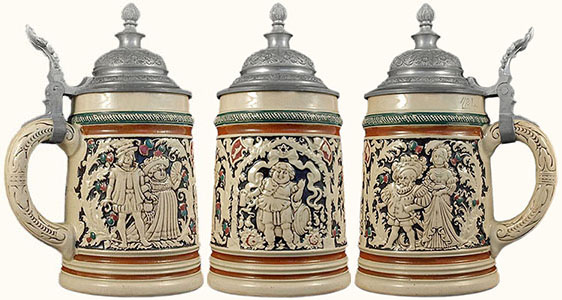 |
The left side depicts a man in typical merchant class period garb strolling arm-in-arm with his wife, who is shown as plain, dumpy and generally unattractive. Neither of them appear to be particularly happy about being with the other. On the right, the unappealing (and almost laughable) half of the pictured couple is the man, whose outfit and puffed up bearing mark him clearly as a member of the upper class, perhaps even a titled peer of the realm. He’s shown walking with his statuesque “trophy wife,” but again, neither of them looks all that thrilled to be there,
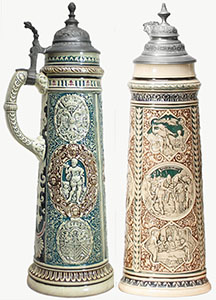 |
Some other good examples of this immediately recognizable Dümler style can be seen in model No. 34, titled “Three Drinking Kings,” and No. 85 called “Long Live Gemüthlichkeit.”
Another group of steins that are relatively easy to pick out as Dümler designs are his Siegburg Schnelle-style pieces, no doubt drawn from originals in his personal collection. Two of them are shown in Figure 9. Both steins display the general configuration and types of imagery commonly found on 15th century Siegburg stoneware. The 1.5-liter stein on the left (No. 52, circa 1885) is decorated with Renaissance period heraldry. On top of the central warrior image we see arms dominated by a two-headed eagle, the heraldic symbol of the Holy Roman Emperor. The arms below the warrior feature rampant lions and almost certainly belonged to the House of Habsburg, one of the most important royal families in Europe and the source of Holy Roman Emperors from 1438 through 1740.6
The 2-liter stein on the right in Figure 9 (No. 391, circa 1895) displays three biblical images, typical of those regularly seen on the work of Renaissance potters. In this case, according to the manufacturer’s catalog, we see depictions of “Abrahams Opfer” (Abraham’s Offer); “Melchisedech” (or Melchizedek, a biblical king of Jerusalem); and “Einkehr der Fremdlinge” (Entering of the Strangers).
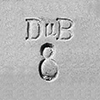 |
An interesting sidelight to these two pieces is that they have both also been seen in presumably earlier versions, looking more like Siegburg originals, with no coloring, more primitive handles, and plain relief bands above and below the central design.7 Although no documentation regarding their provenance is known to exist, it’s likely that the two steins were manufactured by Dümler & Breiden as a means of gaining some early recognition, not to mention a little cash flow, in the pre-catalog period of their newly founded company (i.e., 1883 through early 1884). This supposition is bolstered by the fact that one of the two bears the only base mark (Figure 10) ever seen on a D&B stein produced prior to Peter Dümler’s death in 1907. We can only speculate as to the reason the mark never appeared on subsequently produced cataloged items.8
Some additional perspective on Peter Dümler designs inspired by Renaissance art and artists can be gained with a look at model Nos. 35, 44 and 249.
Anti-Semitic
A group of pieces that many would consider unworthy of an artist with the talent and standing of Peter Dümler are his anti-Semitic offerings. Although clearly distasteful by today’s standards, they are distinctively Dümler designs, and for our present purposes should not be overlooked.
Probably the best known of several he produced are a pair of ½-liter steins, both circa 1892, displaying wraparound derogatory images of Jews in 19th century German society, accompanied by text that might best be described as venomous. The first of these (No. 299), bearing Dümler’s signature in the mold, is titled simply “Freedom,” an unlikely name for a stein that depicts Jews being literally chased out of the country.
If anything, the second of this pair (No. 300), called “Germania Crushes the Serpent’s Head Underfoot” in the manufacturer’s catalog, is even more distasteful and disconcerting than the first, but may help to put into perspective the environment in which the two steins were created. It’s the lid inlay more than anything else that distinguishes this one from its mate. The inlay typically seen on this stein features strongly worded anti-Semitic quotes from five prominent Germans, ranging from Martin Luther to Otto von Bismarck.
Anti-Semitism had been growing in Germany for centuries, fueled in Peter Dümler’s time by the German Socialist movement of the mid-19th century. It’s unclear at this point whether Dümler was an anti-Semite himself or simply responding to the demands of the marketplace. However, the fact that it’s not unknown for anti-Semitic symbolism to appear even on otherwise innocuous Dümler designs tends to argue for the later (see, for instance No. 138). In any event, anti-Semitism would appear to have been the prevailing attitude in many parts of Germany at the time, which helps at least to explain Dümler’s decision to produce these steins, although certainly not to justify it.
Figural
This discussion of Peter Dümler’s art on beer steins could hardly be considered complete without a look at his figural or character steins. Of the nine figural steins introduced by D&B during Dümler’s lifetime, five designs can be credited to him with absolute certainty given their low model numbers, and the other four with considerable confidence based imagery style. Given the popularity of figural steins with collectors in general, all nine of Dümler’s contributions to the category are shown in Figures 11 and 12, in a variety of available color configurations. All but one has a ½-liter capacity.
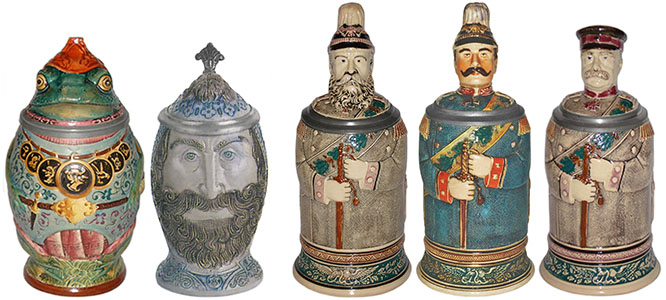 |
On the left in Figure 11 is Dümler’s first figural stein (No. 27, circa 1884), entitled “Frog as Roman Commander.” In addition to being the first, it’s by far the most interesting, in that the image recalls one of his most often visited subjects, the Battle of Teutoburg Forest. Note particularly the medallions around the frog’s neck. Where one might expect to find images of deities and fierce animals typically used on Roman military decorations, what we find instead is a relatively silly looking soldier on the foremost medal, flanked on either side by images of jesters and farm animals. The objective, of course, was to portray Roman military leadership as a bunch of bloated, frog-like incompetents, whose loss of three legions in 9 A.D. can thereby be easily understood.
Next to the frog is a “Knight Head” (No. 46, circa 1885), followed by three leaders of the German Empire: Friedrich III (No. 185); Wilhelm II (No. 186); and “Prince Bismarck” (No. 192), all circa 1889, the year following the death of Wilhelm I, Germany’s first emperor, and the crowning in quick succession of Friedrich III and his son Wilhelm II. The overall configuration of these three steins is relatively generic and similar designs can be seen from several other manufacturers, but it’s probably true that when depicting the people who controlled your life, one was well advised to not stray far from the norm. What distinguishes these pieces from the competition most clearly are their recessed bases, featuring a German imperial eagle in the forefront. It should be noted, however, that all three also exist in blue-gray stoneware versions without the distinctive base.
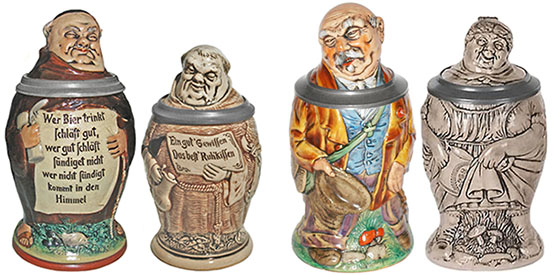 |
The four figural steins in Figure 12 were all introduced by D&B following the turn of the century, more than ten years later, and consequently cannot be credited to Peter Dümler based on their model numbers. However, the caricature-like styling that comes through clearly on all four is, here again, a trait that points directly to Dümler.
Almost every significant Westerwald beer stein manufacturer produced at least one, and sometimes several, monk character steins. As a group, they’re pretty much straight-forward and unimaginative depictions, often distinguishable from each other only with detailed examination. The two D&B monks, on the other hand (No. 572, ½-ltr., circa 1900 and No. 654, ¼-ltr, circa 1904) are quite expressive and appear almost able to convey their messages, both about the contribution to sound sleep made by a clear conscience, even without benefit of the signs they carry.
Even the casual observer of D&B’s “Vagabond” and “Vagabond’s Wife” (Nos. 723 and 724, respectively, circa 1904) could hardly miss the styling similarities shared with the two monks, all four of which hearken back strongly to Dümler’s earlier Renaissance caricature pieces.
For purposes of completeness, it should be noted that Dümler & Breiden also produced two additional figural steins, the first (No. 852) in the realistic skull-like configuration that had become enormously popular with German students. However, its 1908 release date makes it highly improbable that Peter Dümler was in any way associated with the design.
The second, a navy reservist souvenir (No. 1007), was a special order piece made for Paul Klütsch, owner of a finishing shop and distributor in Coblenz which provided the individual personalization. First produced circa 1911, the design of this stein is almost certainly not attributable to Peter Dümler. Nonetheless, its relative rarity combined with its strong appeal to both figural and reservist stein collectors, the two largest specialty collectors groups, make this stein one of the most expensive to own among D&B offerings.
Additional Physical Characteristics of Pre-1907 D&B Steins
As we’ve already seen, a sometimes critical element in crediting a particular design to Peter Dümler is recognizing that the stein was made by D&B in the first place. Since D&B base markings are typically limited to only a model number, this can often be a challenging task. Moreover, there are many collectors whose interest in early Dümler & Breiden steins isn’t necessarily limited to Peter Dümler designs. So in this section we’ll look at some characteristics of pre-1907 D&B steins, beyond the relatively rare appearance of Peter Dümler’s initials, that can be relied on to provide positive identification.
Body and Lid Identifiers
 |
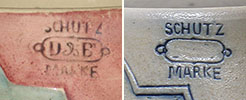 |
 |
It’s probably worth mentioning here that for a few years early on D&B marked some of their steins with an impressed “MUSTERSCHUTZ” (i.e., design protected) in all caps and Helvetica type. Unfortunately, as a means of identification it falls somewhat short because literally identical markings can also be found on early Thewalt steins, but in the absence of any other clear identifiers it’s at least a start.
Handles
In the period prior to 1907 Dümler & Breiden used more then 80 different handles on their beer steins, with much of the variety occurring on larger pieces (1½ liters and up), which were often fitted with one-of-a-kind handles. For smaller steins, those more likely to be used for drinking rather than just display, handle designs were frequently reused, providing one of the most broad-ranging and reliable means of identification. But as we shall see, it’s not necessarily an exact science.
 |
The most commonly seen D&B handles, together accounting for those used on perhaps 75-80% of D&B steins with capacities under one liter, are shown in Figure 16 in three separate groups. The four handles on the left are grouped together simply because they all display a similar characteristic — a knuckled band that appears to resemble a roller bearing (i.e., individual bearings contained in a ring). At least one Reinhold Hanke handle has been seen with the same kind of knuckled band (possibly even designed by Peter Dümler), and there may well be additional non-D&B examples yet to be cataloged, but if you spot one, without even considering the other components of the design, the chances are pretty good that you’re looking at a D&B stein.
The middle group of five handles share no such similarity and are shown together simply as a means of separating them from the pair on the right. Each of the five is unique to D&B, and like the first four provide an absolutely positive means of identification. It should be noted that the last of this group, featuring a soldier’s head at the top, was used exclusively on D&B regimental steins. Nos. 744 and 1003 are typical examples. These steins, which were produced in more than twenty different models, were quite popular at the time and, consequently, the pictured handle could easily be the D&B handle most frequently seen by collectors today.
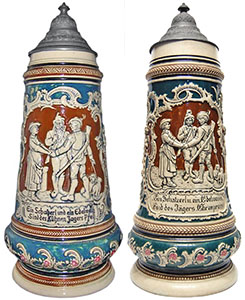 |
The first (left) of the two is particularly problematic, in that a literally identical handle can be found on steins manufactured by A.J. Thewalt. When first encountered, my initial reaction was that it must be some kind of aberration — perhaps a well done handle replacement. Surely two manufacturers could not have been using exactly the same handle. But as additional examples began to appear, the evidence became impossible to ignore. At this point, even the previously overlooked fact that both companies used similar “MUSTERSCHUTZ” marks began to take on significance.
Further research uncovered even more similarities between some D&B and Thewalt steins. The clearest example of those discovered so far can be seen in Figure 17. On the left is D&B No. 594, circa 1900, and on the right is Thewalt No. 148, produced in approximately the same timeframe. The similarities are hard to miss. What’s more difficult is spotting the differences. So the search for an explanation began.
As it turns out, Thewalt’s principal artist in the company’s early years, Wilhelm Kamp, had spent a year training with Peter Dümler before starting his employment with Thewalt in 1897.9 Given this fact, the obvious conclusion is that the result of some of Kamp’s efforts while he worked under Dümler’s guiding hand were taken with him to his new employer, including most significantly the first of our two problem handles.
The other problem handle, shown in Figure 16 at the far right, presents a similar dilemma. It appears on a number of D&B steins, but an almost identical handle can also be found on a fairly wide range of steins produced by the Adolf Diesinger factory. There are some minor differences in the scrollwork appearing at the corners of the handle on both ends, but they’re virtually undetectable absent a side-by-side comparison.
Unfortunately, this one is not quite as easily explained. In fact, we currently don’t even know who the Diesinger artists were, much less what kind of relationship any of them might have had with Peter Dümler. However, based on what’s been discovered with respect to the Thewalt handle, it’s hardly much of a stretch to imagine yet another artist, having been tutored by Peter Dümler, taking some of the results of his training with him to Diesinger.
At the bottom line, of course, the practical effect is the same whether we know why the similarities occurred or not. The fact is that they exist, and any handle-based identification of a D&B stein must take that into consideration. Fortunately, the problem will need to be faced in only a relatively small number of cases.
Paul Dümler and the Terra Sigillata Period
By 1907, the Jugendstil (literally “youth style”) era was finally in full swing in Kannenbäckerland, producing a dramatic shift in the kinds of beer steins that were being sold by Westerwald manufacturers. In no case would the change be more far-reaching than at Dümler & Breiden where, within just a few years, production of most traditional steins would come to virtual halt.10 They would be replaced by a product line composed mainly of the Jugendstil designs of Paul Dümler, almost all with the distinctive terra sigillata finish, which as a group make up the second of our two “most desirable” D&B stein collecting categories.
When we recall the confluence of events that were directly impacting Dümler & Breiden at the time, i.e., the death of Peter Dümler, Paul Dümler’s coming of age as an artist and designer, and the unveiling of terra sigillata, the reasoning behind D&B’s product line overhaul begins to become clear.
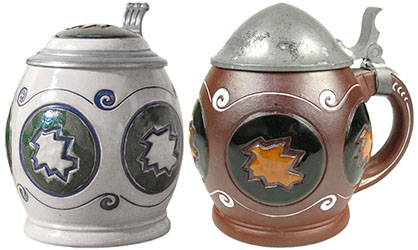 |
The situation at Dümler & Breiden, meanwhile, was very different. As of 1907, the design genius of Peter Dümler that had in large part been responsible for the company’s success to that point was no longer available. In his place was a young man who, by both schooling and inclination, was a Jugendstil artist. And then there was the terra sigillata, which produced a finish that was being well received by consumers, that no competitor was able to duplicate, and that seemed almost perfectly suited to the modern designs being produced by Paul Dümler. For practical purposes, the decision by D&B to effectively abandon most traditional offerings was the only one the company could have made.
It was noted earlier that the first beer stein described in a D&B catalog as “terra sigillata” (model No. 937) was introduced in 1910, but it’s quite possible that beer stein designs by Paul Dümler, first produced with traditional glazes and cataloged as such, were actually remade with the a terra sigillata finish as early as 1907, when that glaze treatment was introduced. For example, Figure 18 shows two versions of model No. 788, the stein on the left was first produced circa 1906 (i.e., pre-terra sigillata) while the one on the right could not have been produced any earlier than 1907, but most likely appeared with a terra sigillata finish well before 1910.
Between 1910 and the early 1920s, Dümler & Breiden produced well over 300 terra sigillata products, generally believed to have all been designed by Paul Dümler prior to his departure for war in 1914. Stylistically the beer steins that are known to exist from the period certainly exhibit similar characteristics, and at least one credible researcher, in cataloging a number of D&B terra sigillata offerings from 1912 to 1920, credits them all to Paul Dümler in apparent agreement of that conclusion.11 To some extent, support for that position is also provided by the fact that during much of the period in question Germany was at war, and available evidence also seems to indicate that was no one hired to replace Paul Dümler until his cousin, Ernst Dümler, came on board in 1920.
The five steins shown in Figure 19 are just a small sampling of Paul Dümler’s terra sigillata output, selected to illustrate, at least to some extent, variations in form and subject-matter. Additional examples may be seen by simply clicking through the online Dümler & Breiden Stein Catalog, starting at model No. 937 and advancing through the 1300s.
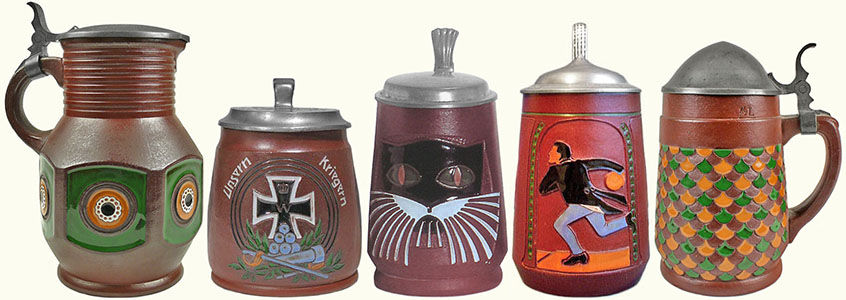 |
Dümler & Breiden continued to produce terra sigillata wares well into the 1930s, some of which are stylistically similar earlier Paul Dümler designs, but as we’ve already noted, beginning in the early 1920s terra sigillata was typically only one among a number of available glaze options. Moreover, the later designs were often what might be fairly described as “uninspired.” From a collecting standpoint, most of the best D&B terra sigillata steins are the designs that are believed to have been created by Paul Dümler himself, carrying model numbers no higher than the 1300s.
Marks on D&B Terra Sigillata Steins
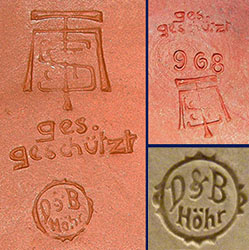 |
Normally seen together with “ges. geschützt” (legally protected), it also appears regularly in conjunction with another mark showing “D&B/Höhr” in a circle. The circular mark has also been seen independently, but only rarely, on non-terra sigillata wares, the rarity for the most part attributable to the relatively small number of non-terra sigillata items that were being produced at the time — which brings us to the question of usage dates.
The existence of the two marks shown in Figure 20 has been pretty well documented. Unfortunately, previously available statements of usage dates for these and most other known D&B base marks have been either substantially inaccurate or almost uselessly vague, sometimes both. For example, the highly regarded Keramik-Marken Lexikon12 shows the usage dates for the TS mark seen in Figure 20 as “vor 1900–(1924)” (i.e., before 1900 to circa 1924), which is well off the mark on both ends. Unfortunately, these dates have also been picked up and republished in any number of secondary sources.
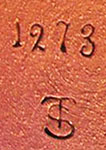 |
Intensive observation over several years has led to the clear conclusion that the ending usage date for the TS mark in figure 20 is circa 1920, generally coinciding with the initial production of the last of Paul Dümler’s terra sigillata designs and the arrival of designer Ernst Dümler on the scene. It’s unlikely at this point that it will ever be possible to determine how much (if any) meaning should be applied to this coincidence, but the fact remains that the likely initial production date of the highest model number so far observed bearing this mark (No. 1290) coincides precisely with the 1920 change in D&B’s artistic leadership.
Moving to the circular “D&B/Höhr” mark, previously published sources are again typically well outside any acceptable margin of error, ranging from the precise but inaccurate “1910”15, to the broad and generally unhelpful “early 1900s.”16 In fact, again based on actual observation, the circular mark appears to have been first used at pretty much the same time as the stylized TS. Its use in conjunction with the TS mark was no doubt initially intended as way for D&B to ensure recognition, not only of the product, but also its producer, while the stand-alone usage would achieve the same end for non-terra sigillata wares. As we have seen, by circa 1910 D&B had shifted its production almost exclusively to terra sigillata, thereby obviating the need for the “D&B/Höhr” mark as a stand-alone symbol. In subsequent years the TS mark would have likely become so closely associated with Dümler & Breiden that the circular D&B Höhr had, for practical purposes outgrown its usefulness. In any event, the last observed usage of that mark on a stein as of this writing has been on D&B model No. 1100, circa 1915.
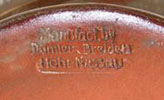 |
Although it might be tempting to dismiss stand-alone usage of the plain TS mark on pre-1920 models as simply the result of application on reissues of the earlier items, that explanation fails when the plain TS is found partnered with the D&B/Höhr mark (i.e., 1915 or earlier). While the reason for using both the stylized TS and the plain TS simultaneously may never be satisfactorily explained, it’s all but certain that simultaneous use took place, most likely from 1907 forward.
To summarize, based on actual observation and other considerations discussed above, the probable usage date for the three most commonly observed marks on Dümler & Breiden terra sigillata steins are:
Stylized TS: 1907 – circa 1920
Plain TS: 1907 — circa 1930
Circular D&B/Höhr: 1907 – circa 1915
Before ending this discussion, it should be noted that one additional D&B mark is known to exist on terra sigillata, although at this point it appears to be quite rare. The mark, shown in figure 22 and reading “Manufact. by/Dümler & Breiden/Höhr Nassau,” was found on a tobacco jar dated 1919. The “Manufact. by” portion of the mark seemingly indicates that the product was intended for export, but other than that there’s little to be learned from this single example. How frequently the mark was used, and whether or not it was applied to beer steins at all, are questions still to be answered.
Identification and Dating of Post-1920 D&B Steins
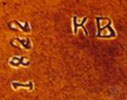 |
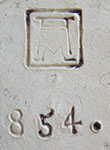 |
During the decade of the 1920s, base mark identifiers were applied only rarely on D&B steins. This problem is compounded by the fact that there are no manufacturer’s catalogs extant that were published any later than 1912. Consequently, even where a particular piece is thought to possess “collectible” characteristics and a stylistic connection is somehow made to Dümler & Breiden, only two infrequently seen indicators exist to confirm such a judgment that don’t leave considerable room for doubt. One, of course, is the “plain TS” mark discussed above, applicable to only a portion of the scattered terra sigillata offerings after 1920, and the other wasn’t really intended as an identifier at all.
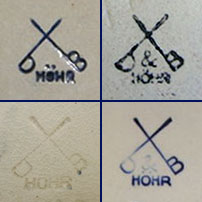 |
Others have suggested that the initials stand for K�lnische Braun (Cologne brown), a speckled brown glaze often seen on D&B wares produced during the period in question. Given the fact that D&B regularly used a “TS” base mark to identify its terra sigillata products, it would certainly have been consistent to apply a “KB” base mark to identify items glazed in K�lnische Braun. However, it should be noted that there have been confirmed sightings of examples bearing the KB mark in conjunction with glazes other than K�lnische Braun.
A third possibility is that the KB was simply an inspection mark, but regardless, the mark is currently believed to be a trait exclusive to D&B and has so far proven to be a highly reliable recognition device.
As they moved into the 1930s, Dümler & Breiden began applying identifying base marks with a much higher degree of frequency. Some examples are shown in Figure 25. As may be seen, the marks existed in two basic configurations, both showing stylized crossed swords with a “D” and a ”B” used to represent the hilts, but distinguishable from each other by the inclusion or exclusion of an ampersand (&) between the swords. Both versions can be found either impressed, impressed and inked, or just stamped (in varying colors) on D&B steins.
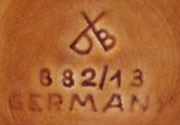 |
The final mark we’ll look at is shown in Figure 26. This mark was put in place circa 1958 and can be found on virtually all Dümler & Breiden wares manufactured from that point forward. This particular example, however, is the single currently known instance of the mark being applied to a beer stein. Since D&B had effectively exited the stein manufacturing business some time earlier, the likelihood of finding more than a handful of additional examples is believed to be relatively limited.
The mold number accompanying the mark is also worth a mention, in that by this time D&B had transitioned to a new numbering system for identifying its art pottery that, as here, used a 3-digit shape code combined with a 2-digit size code, expressed in centimeters, making this particular stein-shaped vessel thirteen centimeters in height. Unfortunately, because of the change in numbering systems there is no way to determine a production date for the piece, which theoretically could have been manufactured at any point between 1958 and the termination of the firm’s operations 1992.
A Closing Thought
With that we conclude our look at the Westerwald firm of Dümler & Breiden from a beer stein collecting perspective. When research began for this project a number of years ago, it quickly became clear to me that as collectors we had a lot to learn. As we have seen, the steins they produced can often be described as “unique” or “outstanding,” yet for the most part collectors were hard-pressed to even identify them as D&B products.
At this point, a great deal of progress has been made, progress that would not have been possible without the cooperation of literally dozens of people who willingly and without compensation took the time to contribute the photographs and facts that allowed for the creation of a Dümler & Breiden Stein Catalog in the Beer Stein Library, and in so doing helped to build one of the primary resources from which this article has been drawn.
However, it’s important to emphasize that our knowledge of D&B steins is far from complete. There is much yet to be learned, but it won’t happen without an ongoing, cooperative collector effort. Readers, particularly those who may have been aided by this article in the detection of a heretofore unrecognized D&B stein, are encouraged to contribute to that effort by sending photographs and related information to [email protected].
__________
1 Here and elsewhere throughout this text, stated initial production dates have generally been computed using a straight-line arithmetic progression, the result of which has so far matched up fairly precisely with all available dates certain. Control dates were drawn from sources that include dates cast into the bodies of specific D&B steins, known catalog production dates, and dates of various contemporaneous historical events. Dividing the model number by 35, and then adding the rounded-up quotient to the 1883 founding date of Dümler & Breiden, consistently produced a reliable initial release date for control group steins through model No. 1000, the last number appearing in a 1912 (latest known) D&B catalog. Between 1912 and 1920, D&B appears to have introduced approximately 300 new product designs, and while the likelihood of some fluctuation during the war years is high, the same formula has been applied and is believed to be reasonably accurate for that period also. After 1920, statements of initial production dates have been based on style and sequence considerations and are generally stated with less precision than those of earlier pieces.
2 The attribution of this stein to Paul Dümler is based exclusively on style and timing considerations. Whatever written documentation might have once existed that could have confirmed this and other similar attributions of unsigned pieces throughout this article has long been lost to the passage of time.
3 The only significant exception was a group of military reservist souvenirs, typically designed to be decorated and lidded by outside finishing shops. See, for instance, Nos. 1011 and 1122.
4 The first ten items in the D&B catalog were all miniatures, among them some tiny “steins” that in all likelihood were intended for use as doll house accessories.
5 See Hanke Stein Catalog listing No. 841.
6 For a close-up view of the arms featured on this stein, see the D&B catalog listing No. 52.
7 To view an example see D&B catalog listing No. 391.
8 The symbol below the “DuB” in Figure 10, though apparently an eight, has no relation to the item listed under that number in the manufacturer’s catalog, which is described as a “Miniature stylized monkey.”
9 This discovery resulted from a series of email exchanges with Albert Thewalt, grandson of the firm’s founder, that were initially aimed at exploring what turned out to be an erroneous report regarding a relationship between Kamp and Peter Dümler’s nephew Ernst Dümler, who would later become D&B’s principal artist. It was only after that approach failed that the search for another link between the two firms began and that documentation of the relationship between Kamp and Peter Dümler was eventually uncovered in the Thewalt company archives.
10 A significant exception was the ongoing production of more traditional military reservist souvenir steins (often referred to by collectors as “regimentals”). Dümler & Breiden produced their first reservist stein circa 1902, and by 1913 had become the most prolific among Westerwald manufacturers of this genre. For obvious reasons, the production of reservist steins ceased completely with the coming of World War I in 1914.
11 Dry-von Zezschwitz, Beate: “Westerwälder Steinzeug des Jugendstil 1900-1914” (Westerwald Art Nouveau Stoneware 1900-1914); unpublished doctoral dissertation; University of Munich; 1993.
12 Zühlsdorff, Dieter: Keramik-Marken Lexikon (Ceramic Marks Encyclopedia); Arnoldsche, Stuttgart; 1994; at page 69.
13 Earlbach, Jürgen and Schimanski, Jürgen; Die Neue Ära (The New Era); Contur-Verlag, Düsseldorf; 1987; at page 38.
14 Dry-von Zezschwitz, Beate: op. cit.
15 Zühlsdorff, Dieter: op. cit. at page 27.
16 Kirsner, Gary: The Beer Stein Book (3rd edition); Glentiques Ltd., Coral Springs, FL; 1999; at page 21.
17 Müller had designed two pieces for D&B circa 1908 (numbered 853 and 854), which are the only two steins known to exist with that mark, and in that very limited sense, it too is a reliable D&B identifier.
__________
Many thanks to:
Armin Seng, who surprised me one morning in the mail with a box full of materials about his great grandfather, Peter Dümler, that I would have never been able to obtain otherwise, and who was also more than generous with his time in responding to follow-up email inquiries. Among other things, his help with naming the people in the front row of Figure 1 allowed for the correction of some previously published confusion between Dümler and Albert Breiden.
Albert Thewalt, who devoted a significant effort to tracking down the relationship between Peter Dümler and Thewalt artist Wilhelm Kamp, and also played a critical role in uncovering some otherwise unobtainable background information on Ernst Dümler.
Walt Vogdes, whose personal archive was the source of the cited Dry-von Zezschwitz doctoral dissertation, which added significantly to my understanding of D&B’s Jugendstil period, and who also volunteered, without hesitation, to spend time putting a number of German language reference documents through his OCR scanner (that can even read umlauted text).
And finally, to the many Beer Stein Library members and others whose efforts produced the hundreds of photographs that are at the heart of the Library’s Dümler & Breiden Stein Catalog, without which this article could have never been written.
__________
© 2010-2020 Beer Stein Library — All rights reserved.